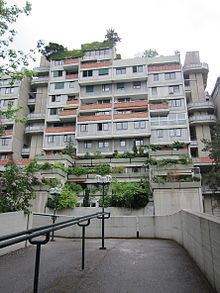Large residential complex
Large residential complexes belong to the type of complex development . Large-scale residential complexes are building structures that, due to their size and scale, stand between the urban structure and the architectural object in the urban space. Large-scale residential complexes were developed in the 1960s / 1970s under the urban planning model of “urbanity through density”. Although they can contain different buildings and resemble city quarters in their expansion, they were erected at one point in time as a "building" and thus form a demarcation to urban structures that have evolved through urban development.
definition
Large residential complexes were placed in the city center within the existing urban fabric and are highly contextual. They were planned with a high proportion of residential use, which was supplemented by other functions. Mixed use (living, offices, medical practices, retail etc.), complexity in the design, spatial density, access to all functions within walking distance, and the outsourcing of car traffic to the basement floors characterize large residential complexes. The specific shape of large residential complexes makes them appear unique in the urban space and, despite the context, promotes the clear demarcation from the surrounding buildings. By building different forms of living (from high-rise over multi-family houses in terrace construction to row, row or detached single-family houses) within the complex, heterogeneous population structures were realized. In the planning of large residential complexes, building in system construction or modular construction was promoted.
history
Large residential complexes increasingly emerged in Western Europe in the 1960s and 1970s. The building structures were shaped by structuralism , brutalism , utopian megastructures and a society that saw technical developments as future-oriented and, due to the economic developments of that time, looked positively into the future.
The interest in large-scale building structures such as large residential complexes declined significantly in the mid-1970s due to social and economic changes. Today a trend can be seen that makes compact, complex building structures with a mixture of functions appear attractive again (cf., for example, “The Interlace”, Singapore).
List of large residential complexes in Western Europe
- London: Lillington and Longmoore Gardens
- London: Brunswick Center
- London: Barbican Center
- Berlin: Autobahn development in Schlangenbader Strasse
- Hanover: Ihmezentrum
- Munich: Olympic Village (Munich)
- Graz: Terraced house settlement Graz St. Peter
- Paris: center of Ivry-sur-Seine
literature
- Beckmann, Karen: Urbanity through density? History and present of the large residential complexes of the 1970s. Bielefeld 2015


